Biorefineries turn biomass into high-value chemicals by using pretreatment methods to break down lignocellulosic materials, making it easier to extract products like ethanol, lactic acid, and succinic acid. Advanced technologies such as physical, chemical, and biological processes help maximize yields. Waste streams are also valorized into valuable chemicals, improving efficiency. With growing industrial demand and investments, bio-based chemicals are becoming key ingredients in various industries — explore further to see how this sustainable transformation unfolds.
Key Takeaways
- Biorefineries convert lignocellulosic biomass into high-value chemicals like ethanol, lactic acid, and succinic acid for various industries.
- Pretreatment processes (mechanical, chemical, biological) enhance biomass accessibility, improving yields of target chemicals.
- Combining multiple processing technologies maximizes efficiency, product quality, and economic viability of biomass valorization.
- Waste streams can be transformed into valuable chemicals through advanced thermochemical methods, reducing disposal costs.
- The industry is rapidly growing, driven by innovation, environmental regulation, and increasing demand for sustainable biobased products.
The Role of Pretreatment in Biomass Conversion
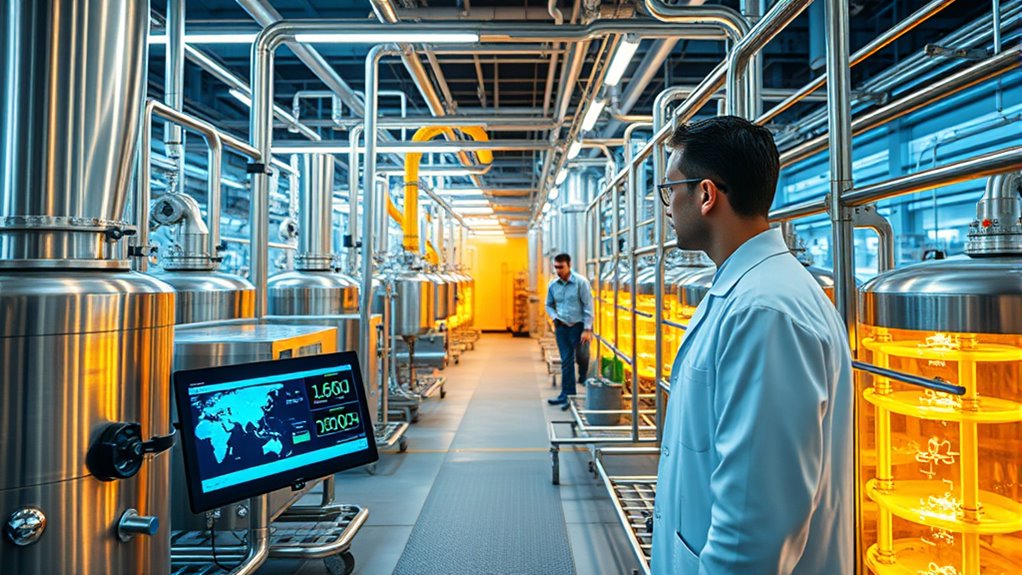
Why is pretreatment a critical step in biomass conversion? It’s because pretreatment breaks down the complex structure of lignocellulosic biomass, making it easier to access valuable components like cellulose and hemicellulose.
Different methods, such as physical, chemical, or biological, target specific biomass features, removing lignin or dislocating hemicelluloses to loosen the matrix. Mechanical pretreatment increases surface area, while chemical processes use acids, alkalis, or solvents to improve digestibility. Biological methods employ fungi or enzymes for selective delignification.
The choice of pretreatment depends on feedstock type, aiming to maximize efficiency and reduce inhibitors. Proper pretreatment can also facilitate uniform processing, leading to more consistent product yields. Effective pretreatment guarantees better enzyme access, boosting downstream processing and ultimately increasing product yields in biorefinery operations. Water parks can serve as a fun analogy, illustrating how breaking down barriers makes access easier and more efficient. Additionally, selecting the appropriate pretreatment method can minimize the formation of inhibitors, which can hinder fermentation processes.
Key Platform Chemicals Derived From Biomass
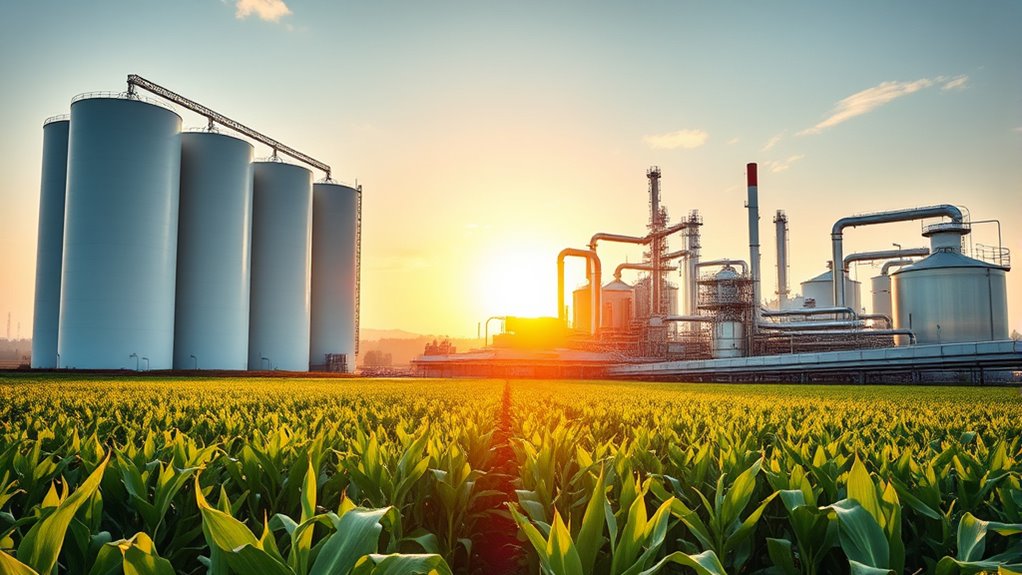
Biomass serves as a rich source of key platform chemicals that can be transformed into a wide array of value-added products. Ethanol, widely used as a biofuel and solvent, is produced through established fermentation processes from biomass.
Biomass provides essential platform chemicals for diverse sustainable products and fuels.
Lactic acid, derived from carbohydrates, acts as a precursor for biodegradable plastics like polylactic acid (PLA), meeting demands in food, pharmaceuticals, and polymers. Succinic acid is essential for biodegradable polymers and pharmaceuticals, while levulinic acid offers versatility for sustainable fuels, polymers, and additives.
Furfural and HMF, obtained from lignocellulosic biomass, serve as starting materials for renewable chemicals and plastics. Glycerol, sorbitol, and xylitol, byproducts of biodiesel and carbohydrate processing, enhance biorefinery economics. Biorefinery economics are increasingly being optimized through AI-driven innovations to improve efficiency and reduce costs. Additionally, understanding biorefinery processes can help maximize the extraction and conversion of biomass into valuable chemicals.
These chemicals showcase biomass’s potential to replace fossil-based raw materials across industries.
Technologies Powering Modern Biorefineries

Modern biorefineries rely on a range of advanced technologies that efficiently convert biomass into valuable products. Mechanical pretreatments like grinding, milling, pressing, and biomass fractionation increase surface area and break down cell walls, making biomass more accessible for subsequent processes. Vetted techniques ensure safety and effectiveness in processing diverse feedstocks. Steam explosion, a widely used physical pretreatment, employs high-pressure steam followed by rapid depressurization to disrupt structure. Densification methods such as pelletization improve handling and feeding into reactors. Chemical pretreatments use acids, alkalis, or oxidation to break down lignocellulosic structures, facilitating the separation of cellulose, hemicellulose, and lignin. These pretreatments prepare biomass for enzymatic hydrolysis, fermentation, or thermochemical conversion. Combining these technologies maximizes efficiency, yield, and product quality throughout the biorefinery process chain. Incorporating biomass fractionation techniques can further enhance the separation and purification of valuable compounds from raw biomass. Utilizing modern separation methods can also optimize the purification process, ensuring higher quality end-products.
Valorization of Waste Streams for Added Value
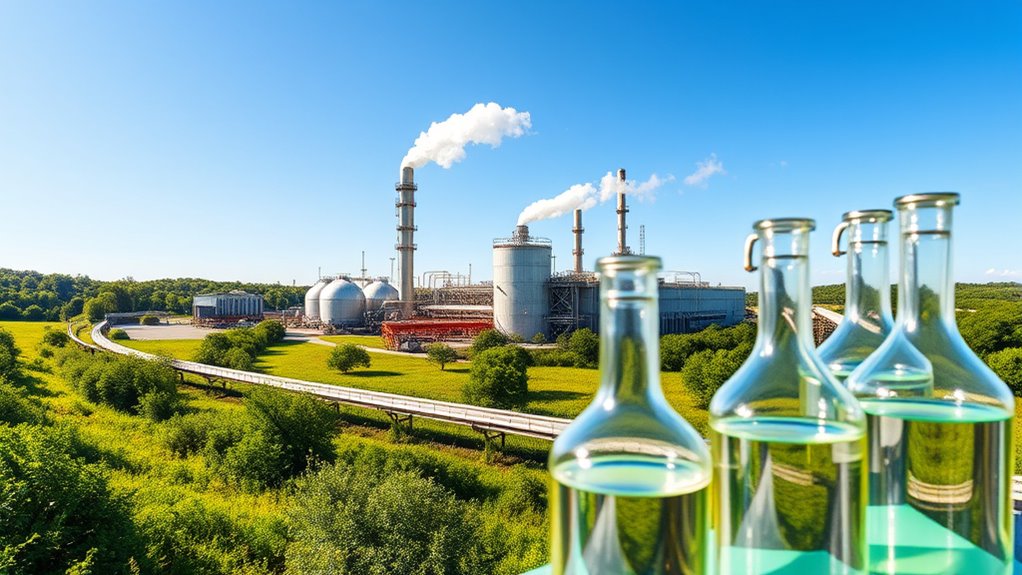
Waste streams generated by biorefineries contain valuable organic compounds, but their dilute nature presents significant challenges for effective reuse. Since these streams are less than 3% organic, separating useful chemicals like phenol and catechol is difficult and costly. Electric dirt bikes are capable of producing between 10 to 20 horsepower, offering an alternative energy source for sustainable operations. Direct discharge is prohibited due to environmental regulations, leading to higher wastewater treatment expenses. To overcome these hurdles, you can employ advanced technologies like thermochemical processing to convert waste into high-value chemicals, improving profitability and sustainability. Valorization not only reduces waste disposal costs but also aligns with eco-friendly goals by producing renewable chemicals from waste. By efficiently recovering compounds, you enhance the overall economic and environmental performance of biorefineries, turning waste into a strategic resource for sustainable development and diversified product portfolios.
Industrial Trends and Economic Impact of Bio-Based Chemicals
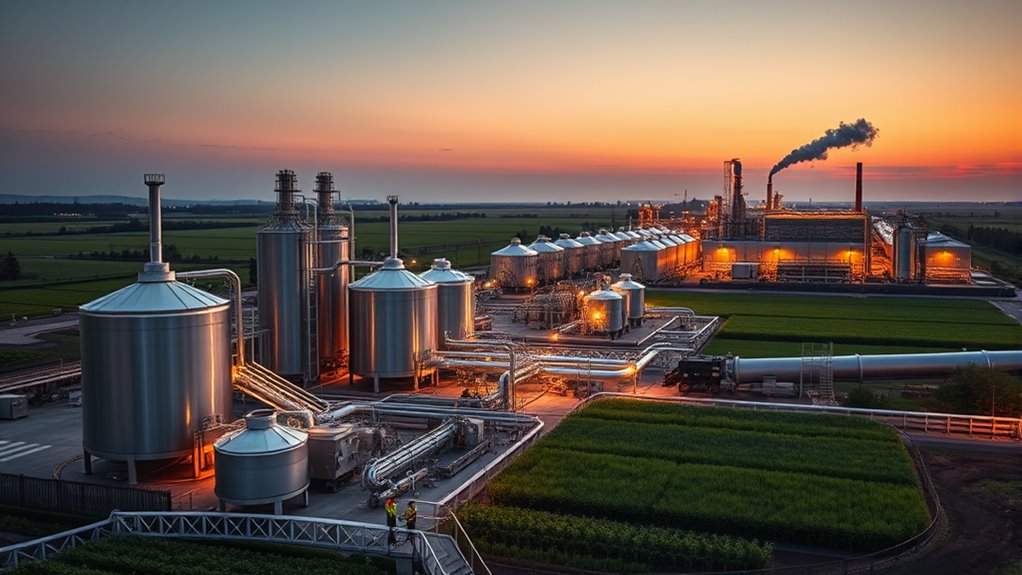
The industrial landscape is rapidly shifting toward bio-based chemicals, driven by technological innovations, regulatory support, and growing environmental awareness. You’ll notice the market’s explosive growth, expected to reach nearly USD 144.6 billion by 2028 and USD 296.5 billion by 2032, with a CAGR around 9.2-9.4%.
Advances in enzyme technology, metabolic engineering, and bioprocessing are boosting efficiency and reducing costs, attracting over $10 billion in global investment in 2023.
Regulations like Europe’s REACH and sustainability targets are encouraging industries to adopt bio-based alternatives. Partnerships between chemical producers and end-users are increasing, reflecting strong market integration.
Applications of Biomass-Derived Chemicals in Industry
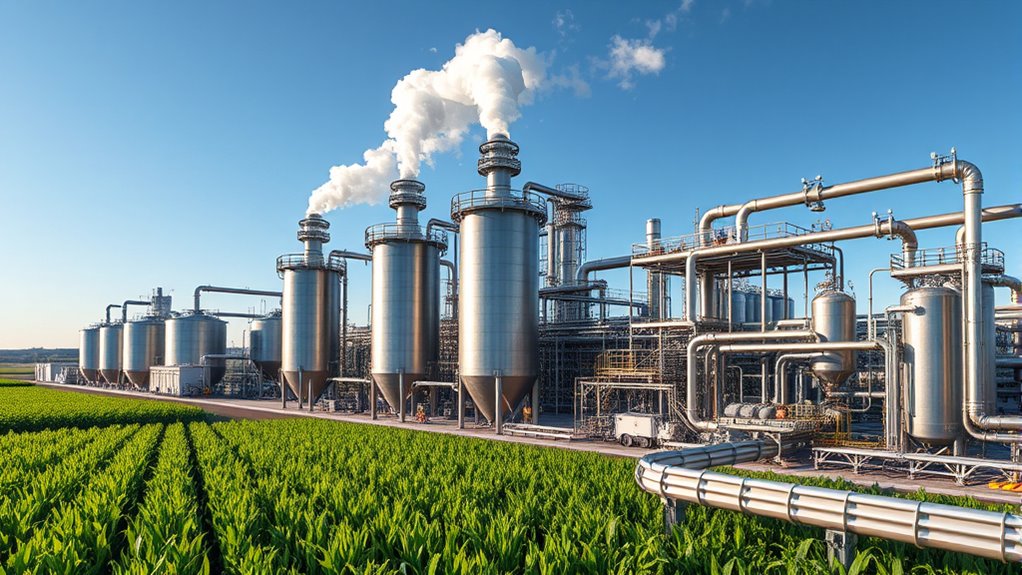
Have you ever considered how biomass-derived chemicals are transforming various industries? These materials play a key role across sectors.
In the chemical industry, fermentation products like ethanol, citric acid, and sorbitol are used in manufacturing processes. Companies like BASF utilize the biomass balance method to replace fossil resources, maintaining product quality while boosting sustainability.
Biomass-derived carbon sources serve in energy, soil remediation, and catalysis, highlighting their versatility.
In pharmaceuticals, bio-based active ingredients and greener synthesis methods reduce environmental impact.
The food industry benefits from biomass chemicals as additives, flavors, and preservatives, while biodegradable packaging from bioplastics offers sustainability.
In cosmetics, glycerol and citric acid serve as moisturizers and antioxidants.
Advanced materials like PLA and biomass-derived carbon fibers further demonstrate biomass’s broad industrial applications.
Frequently Asked Questions
How Does Biomass Composition Affect Pretreatment Efficiency?
You should know that biomass composition markedly impacts pretreatment efficiency. High lipid and protein contents tend to reduce effectiveness, while increased ash can improve it.
Lignin and hemicellulose complexity make breaking down biomass more challenging, but pre-soaking and optimized conditions like AFEX can enhance digestibility.
What Are the Environmental Impacts of Biomass Pretreatment Processes?
You should consider that biomass pretreatment impacts the environment through water pollution from chemicals, high energy use, and land changes. Chemical use, like acids, can harm ecosystems, while waste disposal remains a concern.
However, using greener solvents, biological methods, and integrated systems can reduce these impacts. Investing in sustainable technologies and supporting policies will help you minimize environmental harm and promote more eco-friendly biomass processing.
How Scalable Are Current Biorefinery Technologies Globally?
You might wonder how scalable current biorefinery technologies are worldwide. Right now, over 100 plants operate across different regions, mainly in Europe and North America, with emerging activity elsewhere.
However, scaling up faces challenges like feedstock availability, process consistency, and regional infrastructure.
While market growth is promising, successfully expanding these technologies requires overcoming technical hurdles and adapting to local biomass resources and logistics.
What Are the Main Challenges in Pure Chemical Recovery From Waste Streams?
Imagine trying to find a specific needle in a haystack—that’s what pure chemical recovery from waste streams feels like. You face complex, variable mixtures, contaminants, and strict purity standards.
Achieving over 99% separation demands tailored, energy-intensive processes that can be costly and environmentally taxing. You must balance efficiency, regulatory compliance, and sustainability, making it a challenging puzzle to solve consistently across different waste streams.
How Do Bio-Based Chemicals Compare Economically to Fossil-Based Alternatives?
You see that bio-based chemicals currently cost more than fossil-based ones because of smaller production scales, variable feedstock prices, and limited infrastructure.
Fossil chemicals benefit from established supply chains and subsidies, making them cheaper. However, advancements in bioprocessing and policy support could lower costs over time.
If you focus on scaling up and improving efficiency, bio-based chemicals could become more competitive, especially given their environmental benefits.
Conclusion
As you explore the world of biorefineries, you’ll find that turning biomass into valuable chemicals gently guides us toward a more sustainable future. While challenges remain, ongoing innovation and thoughtful valorization of waste streams subtly transform what once seemed discarded into promising economic opportunities. Embracing these advancements, you can play a part in shaping a cleaner, greener industry—where nature’s gifts are honored through refined, high-value products that quietly support our shared progress.









